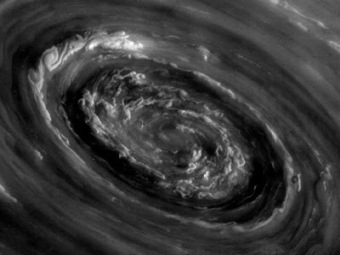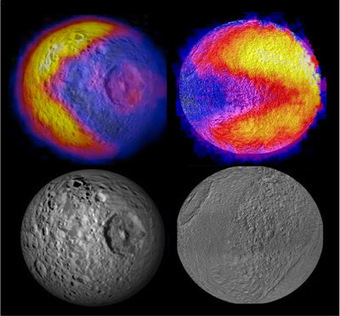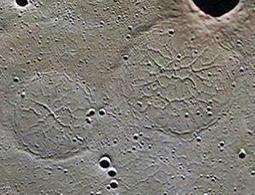Get Started for FREE
Sign up with Facebook Sign up with X
I don't have a Facebook or a X account


 Your new post is loading... Your new post is loading...
 Your new post is loading... Your new post is loading...
This visualization shows the moon's phase and libration throughout the year 2013, at hourly intervals. Each frame represents one hour. In addition, this visualization also shows other relevant information, including moon orbit position, subearth and subsolar points, distance from the Earth. Click each graphic to learn more about what it means! Finally, to learn more about this visualization, or to see what the moon will look like at any hour in 2013, visit http://svs.gsfc.nasa.gov/goto?4000!
Watching a particularly beautiful movie of the Sun helps show how the lines between science and art can sometimes blur.
An interactive 3D visualization of the stellar neighborhood, including over 100,000 nearby stars. Created for the Google Chrome web browser.
Why should you bother to wake up tomorrow knowing that we're all going to die billions and billions of years from now when the universe turns to absolute zero, when the stars blink out, when we have nothing but neutron stars and black holes? Dr. Kaku says that billions of years from now we may be able to move to a different universe.
A red giant star named BD+ 48 740, consumed a rocky world according to observations made by the 9.2 meter Hobby-Eberly Telescope. High amounts of lithium contained in the red giant tell this tale of planetary destruction.
Nuclear fusion at the core of the sun turns hydrogen into helium and provides enough power to keep our star shining for ten billion years.
A combination of:
Do you remember 1982's "TRON"? The Plot: A computer programmer (epic: Jeff Bridges) is digitized inside the software world of a mainframe computer, where he interacts with various programs in his attempt to get back out. I always loved the Light Cycle races and the Solar Ships... In a way, the ISS is a solar ship, constantly rotating around us. A tiny white spot, as it can be seen racing over the sky from time to time, when illuminated by the sunset (and sunrise ;).
Particles from the Sun may be responsible for the presence of water recently detected in lunar soil, a new study has found.
While there’s no official word from NASA on this, the buzz around the blogosphere is that Voyager 1 has left the Solar System.
Mexican archaeologists say they have determined that the ancient Mayas built watchtower-style structures atop the ceremonial ball court at the temples of Chichen Itza to observe the equinoxes and solstices, and they said Friday that the discovery adds to understanding of the many layers of ritual significance that the ball game had for the culture. 
Jimmy Nguyen's curator insight,
January 31, 2014 11:57 PM
the article explains the games held by the mayans in this impressively designed ball court.
The life cycle of a star can follow a few different paths depending on the mass it starts out with. Really massive stars may live for only a few million years before going supernova, while low mass stars such as the Sun may take billions of years to use up their fuel and then die quietly.
Birth - All stars are formed when a giant cloud of gas and dust, called a molecular cloud or nebula, begins to collapse under the influence of its own gravityThis may be triggered by a collision with another molecular cloud, the shockwave from a nearby supernova, or even the collision of galaxiesAs the cloud contracts, it breaks apart. An individual fragment will condense into a hot, dense sphere known as a protostarA new star is born when the protostar becomes hot enough to begin fusing hydrogen into helium. Now, the star will enter the main sequence, or adult, phaseIf a star is too low in mass to initiate nuclear fusion it will become a brown dwarf.
Main sequence - A star will remain in this state for most of its lifetime, fusing hydrogen to make helium and releasing energy in the processA star may fall on different points in the main sequence depending on its mass. In general, the more massive the star the shorter its lifespan on the main sequenceRed dwarfs are small, dim stars that fuse hydrogen at a slow rate, and may remain in the main sequence for hundreds of billions of years.Medium-sized yellow dwarfs such as our Sun will be in the main sequence for several billion yearsLarge stars may only stay in the main sequence for a few million years.
Maturity - Eventually a star will run out of its hydrogen fuel, and begin fusing helium and other elements instead. At that point it will leave the main sequence phaseLow-mass (red dwarf) stars will use up all their hydrogen and collapse directly into white dwarfsMid-sized stars like our Sun will expand and become red giants.This happens when a star runs out of hydrogen at its core. The core will collapse and begin fusing helium while hydrogen fusion is transferred to the outer layersThis causes the star to swell to many times its original size and become cooler as the heat is distributed over a larger areaMore massive stars will grow into supergiants, which are among the largest stars in the UniverseIn this stage a star will maintain hydrostatic equilibrium by fusing heavier and heavier elements as the lighter ones run out. The largest stars can produce elements up to iron.
Death and stellar remnants - Medium-sized stars like our Sun will eventually die by shedding their outer layers as a planetary nebulaThe core will collapse into a white dwarf, which will eventually cool into a black dwarfMore massive stars will die in a tremendous explosion called a supernovaThis happens when a massive stars begins to fuse iron. This absorbs energy and caused the core to violently collapse while the outer layers are ejectedThe extreme heat produced by supernovae is responsible for the nucleosynthesis of elements heavier than iron, up to uraniumAfter a supernova, the core may compress into a neutron star or a black hole.Neutron stars are much denser than white dwarfs, to the point where protons and electrons combine to form neutrons (hence the name)Black holes are denser still, so much so that they produce an extremely strong gravitational force that even light cannot escape.
Via Dr. Stefan Gruenwald |
NASA's Voyager 1 spacecraft has entered a new region at the far reaches of our solar system that scientists feel is the final area the spacecraft has to cross before reaching interstellar space.
You could call this "Pac-Man, the Sequel." Scientists with NASA's Cassini mission have spotted a second feature shaped like the 1980s video game icon in the Saturn system, this time on the moon Tethys.
The Milky Way's supermassive black hole is generally a picky eater, but NASA's NuSTAR spacecraft recently caught it in the act of having a snack!
With wrinkled crust and cracked filling, the unusual formations are unlike anything seen on other rocky planets...
Visit http://science.nasa.gov/ for more. NASA has an unusual candidate for the astronaut corps--a rubber chicken. Seriously.
Astronomers have discovered a new super-Earth in the habitable zone, where liquid water and a stable atmosphere could reside, around the nearby star HD 40307. It is one of three new super-Earths found around the star that has three other low-mass planets orbiting it.
The icy South Pole desert is a harsh and desolate landscape in which few life-forms can flourish.
J. Craig Venter may have just started a race to discover alien life on the Red Planet.
Two high-profile entrepreneurs say they want to put a DNA sequencing machine on the surface of Mars in a bid to prove the existence of extraterrestrial life. In what could become a race for the first extraterrestrial genome, researcher J. Craig Venter said Tuesday that his Maryland academic institute and his company, Synthetic Genomics, would develop a machine capable of sequencing and beaming back DNA data from the planet.
Separately, Jonathan Rothberg, founder of Ion Torrent, a DNA sequencing company, is collaborating on an effort to equip his company's "Personal Genome Machine" for a similar task. "We want to make sure an Ion Torrent goes to Mars," Rothberg said.
Although neither team yet has a berth on Mars rocket, their plans reflect the belief that the simplest way to prove there is life on Mars is to send a DNA sequencing machine. "There will be DNA life forms there," Venter predicted, "you just need the right tools to look for them". Venter said researchers working with him have already begun tests at a Mars-like site in the Mojave Desert. Their goal, he said, is to demonstrate a machine capable of autonomously isolating microbes from soil, sequencing their DNA, and then transmitting the information to a remote computer, as would be required on an unmanned Mars mission.
Meanwhile, Rothberg's Personal Genome Machine is being adapted for Martian conditions as part of a NASA-funded project at Harvard and MIT called SET-G, or "the search for extraterrestrial genomes." Christopher Carr, an MIT research scientist involved in the effort, says his lab is working to shrink Ion Torrent's machine from 30 kilograms down to just three kilograms so that it can fit on a NASA rover. Other tests, already conducted, have determined how well the device can withstand the heavy radiation it would encounter on the way to Mars.
NASA, whose Curiosity rover landed on Mars in August, won't send another rover mission to the planet before at least 2018 (see "The Mars Rover Curiosity Marks a Technological Triumph"), and there's no guarantee a DNA sequencing device would go aboard. "The hard thing about getting to Mars is hitting the NASA specifications," says George Church, a Harvard University researcher and a senior member of the SET-G team. "Venter isn't ahead of anyone else."
"The reason to take a device all the way to Mars and not bring back the sample is because of contamination. No one would believe you," says Tessi Kanavarioti, a chemist who carried out early theoretical work on Martian biology and was involved in studying rocks brought back from the moon in the 1970s. Sequencing machines are so sensitive that if a single Earth germ landed on the sample returned from Mars, it might ruin the experiment.
Discovering and sequencing extraterrestrial life would be an immense scientific prize. Sequencing could reveal whether life evolved in similar ways on both Earth and Mars or, perhaps, moved between the planets. During a series of massive space collisions around four billion years ago, the two bodies exchanged about a billion tons of rocks and debris. So far, NASA researchers have searched Mars for traces of water—a prerequisite for life as we know it—as well as indirect signs that life might have existed there many eons ago. Since DNA molecules don't survive more than a million years, even on Earth, anyone sending a DNA sequencer to Mars has to believe that living microorganisms will be found there now. Sending a DNA sequencer to Mars would be a "high-risk, high-payoff" experiment. It might very well find nothing, but if DNA were discovered, that would provide nearly irrefutable proof of extraterrestrial life. Via Dr. Stefan Gruenwald
An international team of astronomers has discovered an enormous galaxy cluster producing stars at a fantastic pace.
A new study has found that Vesta once had a molten, swirling mass of fluid inside the asteroid that generated a magnetic field.
Using gravitational "lenses" in space, University of Utah astronomers discovered that the centers of the biggest galaxies are growing denser – evidence of repeated collisions and mergers by massive galaxies with 100 billion stars.
|























CB